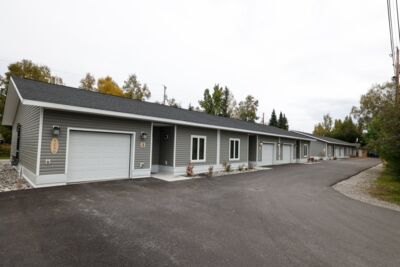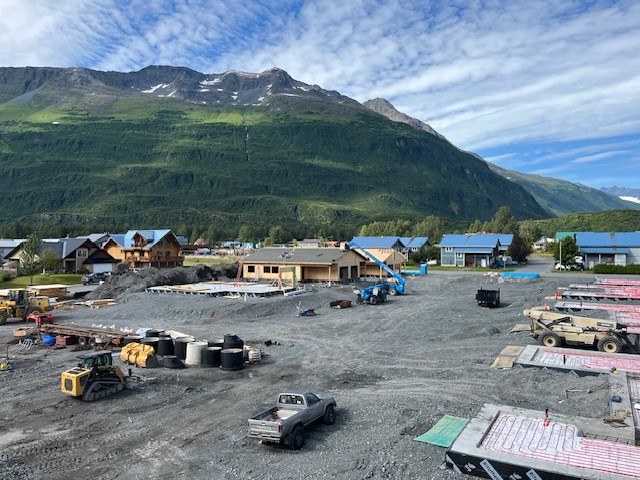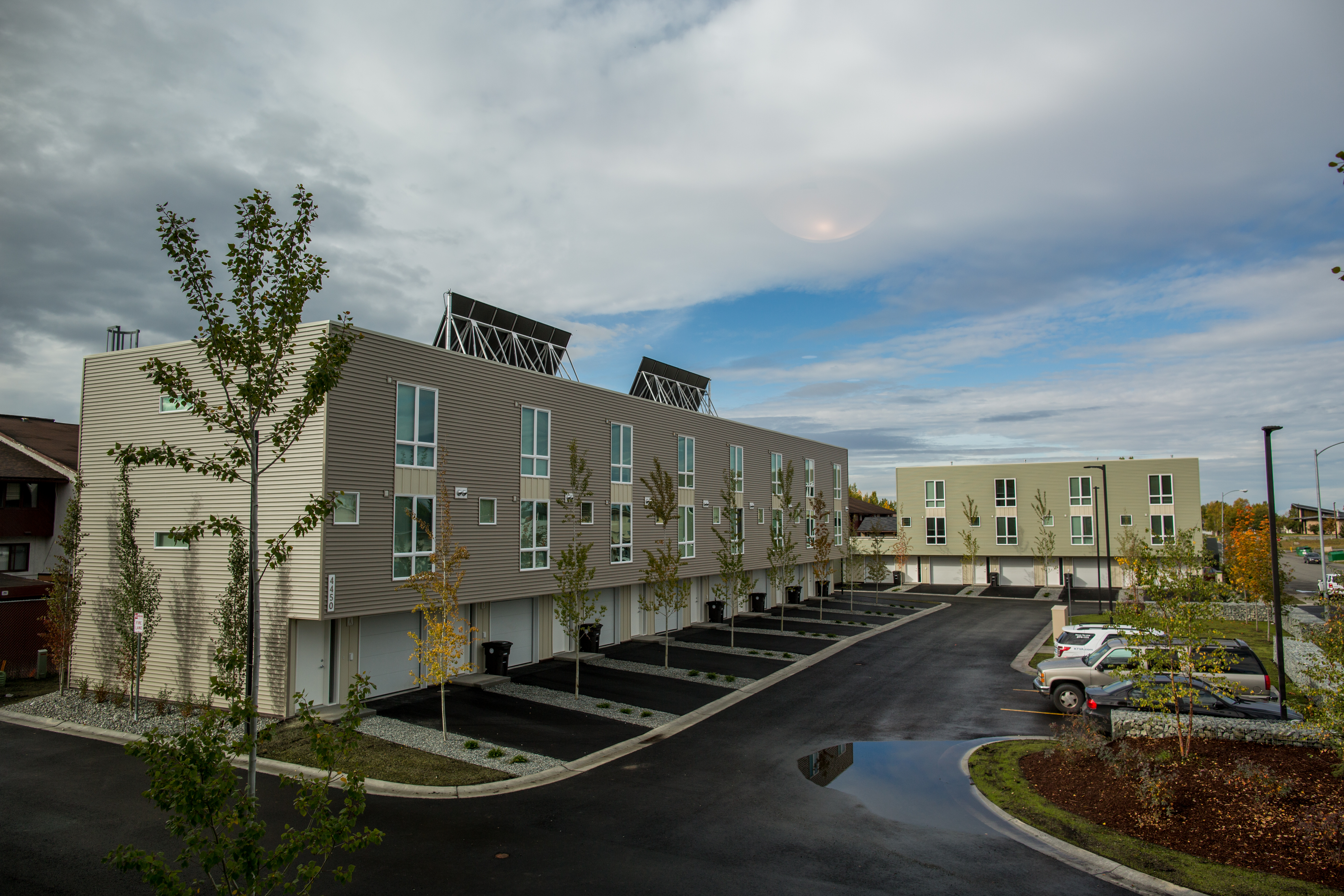Affordable Housing: A New Era of Building Community Throughout Alaska

Alaska is a big state with a small-town character. Neighbors helping neighbors is foundational to the Alaska way of life: it is truly the essence of communities statewide. For Alaska Housing Finance Corporation and its subsidiary, the Alaska Corporation for Affordable Housing, this ethos is synonymous with the mission to provide Alaskans access to safe, quality, affordable housing.
Unique challenges of high building costs, extreme weather and remote geography, keep the state focused on innovative ways to expand its capacity to serve residents in need.
Creative Approaches Bring Change
During the mid-2000s, a broader understanding was beginning to take shape of potential affordable housing needs that lay ahead. Housing vouchers, public housing and tax credit programs provided some options, but economic projections showed they would not keep pace with estimated demands.
While networking at a Moving to Work conference in 2010, Cathy Stone, AHFC’s Public Housing Director, learned of a new approach used by other Moving to Work agencies; the creation of a non-profit housing development arm. The shared knowledge prompted discussions with the management team at Alaska Housing as another option to address Alaska’s growing affordable housing needs.
Building Blocks For A Better Future
In 2011, the State of Alaska passed legislation that allowed Alaska Housing Finance Corporation to establish a subsidiary to further its mission of providing Alaskans access to safe, quality, affordable housing through the acquisition, development, management, or operation of affordable housing.
Alaska Corporation for Affordable Housing was created as a non-profit with the ability to access resources such as loans, grants, Low Income Housing Tax Credits and private funding that are not available to traditional public housing authorities. ACAH utilizes these resources to develop or acquire properties, increase affordable housing opportunities, and bridge the gap in affordable housing. This highly innovative approach is just one of the ways ACAH is able to diversify the housing supply.
The Evolution
Conceptualization and vision are critical for a successful affordable housing development. The stigma attached to affordable housing is dissolving as communities across the country reinvigorate and take a fresh, modern approach to how they develop sustainable affordable communities.
New ideas are nurturing growth that directly address the complexity of community needs and specifically serve targeted populations. It’s no longer just about building a space. From a statewide perspective, everyone needs affordable housing; ACAH evaluates where and how they can do it best.
AHFC’s CEO/Executive Director Bryan Butcher led the effort with AHFC’s board to create ACAH. The approach was intentional investing first in Anchorage, the most populated city with fewest logistical challenges to new development. Movement outside Anchorage was targeted next in Fairbanks and Valdez.
This comprehensive approach has changed the face – and infrastructure – of affordable housing development and ACAH is well-positioned as a leader advancing this evolution of communities with affordable housing.
Susitna Square in Anchorage
Beyond Four Walls
A house is more than a structure for shelter against the elements; it is a place of safety and security for individuals and families from all economic backgrounds, ages and life circumstances. Understanding this, ACAH has worked alongside other experts and trusted local organizations to tap into their knowledge and shared expertise to find the best housing solutions for each community which it has invested.
For more than a decade, ACAH has been effectively employing partnerships. Its first endeavor, Ridgeline Terrace and Susitna Square in Anchorage, set the stage for community engagement. Partnering with Cook Inlet Housing Authority, 88 housing units were brought online.
Ridgeline Terrace, located in the Mountain View neighborhood, is a 5 Star Plus energy rated property consisting of 70-units of family and senior housing. Units feature solar-powered hot water and electricity systems that help reduce tenant-paid utility expenses and operating costs. All units contain washer and dryer hookups, and senior units are sensory and mobility impaired equipped. The land for Ridgeline was purchased from the Anchorage Community Land Trust, a non-profit that works to improve and rejuvenate neighborhoods in Anchorage. Their mission and goals were perfectly aligned with ACAH to create new affordable housing.
“Ridgeline Terrace was groundbreaking at the time and remains an important addition to the Mountain View community and to Anchorage's housing stock as a whole,” says Butcher.
Susitna Square is in the Russian Jack neighborhood and is also an energy efficient property. At Susitna, AHFC demolished 16 units of public housing and redeveloped 18 units in its place. Today, through continued partnerships, ACAH has helped develop more than 250 units of affordable housing, laying the groundwork for subsequent projects in urban and rural communities.
These endeavors offer a new way of thinking about affordable housing. Partnerships representing a balance of public and private entities are coalescing to provide newly constructed housing that would otherwise not exist. While future developments may not involve all of the same entities, ACAH’s framework easily allows for substitutions, making it replicable and relevant to communities across Alaska.
Partnership in Action: Fairbanks Development
This framework was implemented in ACAH’s latest development in Fairbanks, Alaska. With a population of nearly 100,000, the Fairbanks North Star Borough is the second largest populated area within the state, and its economy is supported largely by the neighboring military bases. An increased military presence, coupled with an aging housing stock and lack of affordable housing made this community a natural choice to demonstrate how effective partnerships can respond to housing needs.
Two Sites, Two Communities
The Meadows and Borealis Park represent a scattered site tax credit development under the Fairbanks Affordable Housing partnership. The sites, roughly one mile apart, provide 58 new units of affordable housing for seniors and families whose household incomes are at or below 60% of the area median income.
The Meadows contains 18 ranch-style, accessible single-bedroom units for seniors 55 and older. Borealis Park contains 40 units of family housing including ranch and townhouse styles. Every unit is supported by public housing’s Sponsor-Based Rental Assistance program that allows for households to pay no more than 28.5% of their gross monthly income toward rent and provides the tax credit partner a steady and reliable stream of income.
The housing is designed with energy efficient features to combat Fairbanks’ harsh winters. This includes an amenity not often available to low-income households: a single-car garage. This prevents vehicle freezing and contributes to greater air quality.
“Our Fairbanks development differs from privately developed projects by using and leveraging resources unique to the production of affordable housing in a public/private partnership. Affordability is emphasized, and project financial stability is greatly increased, with sponsor-based rental assistance provided to all households demonstrating the need,” says Michel Chevalier, Principal, North Star Management, LLC.
The development utilized a non-competitive 4% Low-Income Housing Tax Credit from Alaska Housing Finance Corporation. This financial tool, combined with federal financing, lending and generous community partnerships with Rasmuson Foundation and Weidner Apartment Homes made construction of this development possible.
“The leadership Alaska Corporation for Affordable Housing brings to this development includes partnership with eight distinct entities,” says David Pruhs, Mayor of the City of Fairbanks.
“Our government gained relevant and important experience about how we can better partner with outside investors to continue to deliver quality housing that benefits our families and seniors. These new units may be the catalyst to do more good and I’m excited about that possibility!”
The Fairbanks development was made possible by the following public/private partnerships:
- Alaska Housing Finance Corporation – State Housing Finance Agency/Funding Partner/Sponsor Based Rental Assistance
- Alaska Corporation for Affordable Housing – Developer/Non-profit subsidiary of AHFC
- Swell, LLC – Development Consultant
- North Star Management, LLC – Property Manager
- Rasmuson Foundation - Philanthropic Funding Partner
- Weidner Apartment Homes – Philanthropic Funding Partner
- Enterprise – Tax Credit Investor
- First National Bank Alaska
- Eide Bailly LLP - Accountant
Allocating Resources
ACAH’s unique partnership with AHFC allows for innovative leveraging of federal funding and sponsor-based rental assistance through AHFC’s HUD Moving To Work program. Under public housing’s 2026 Moving to Work plan, ACAH can leverage up to $15 million toward affordable housing. The Fairbanks development was the first to bring these benefits forward utilizing $13 million in MTW funding, which represented almost 50% of the total development cost, reducing the need for permanent construction financing through a lender and simplifying the capital stack. Sponsor-based rental assistance delivers the added benefit of operational sustainability and less administrative burden for the property management team.
To provide continual benefits from expended resources, ACAH acted as their own developer and hired a development consultant rather than a third-party developer. This kept the developer fee in-house to be invested into future projects. This innovative strategy also brings development knowledge to the organization that would otherwise stay with a third-party developer. This methodology could be easily replicated by other housing development entities to stretch the use of resources and continue to facilitate new construction projects.
Alaska Ingenuity
Alaska received Moving To Work status through Congressional authorization in 2008. Moving to Work allows innovation and provides the opportunity to design and test locally created strategies that use federal dollars more efficiently, help work-able residents find employment and become self-sufficient, and increase housing choices for low-income residents.
Alaska’s 2012 Making a Home program for youth aging out of foster care was one of the first programs to be replicated and funded by HUD nationwide.
Measures of Success
Fairbanks lacks large land tracts within city limits that are suitable for development.
A scattered site approach is complex in nature but it allowed for an operational scale that was more supportive than if each site was developed independently. The scattered site approach presented the opportunity to serve both seniors and family households, while creating a more achievable operational scale than separately developed sites.
The Fairbanks market presented many significant barriers to the production and operation of affordable housing:
- High development costs related to supply chain and labor shortages
- High operating costs
- Increasing rents widening the affordability gap
- Long-term affordability obstacles – i.e. properties transitioning to market rate
The success of Alaska Corporation for Affordable Housing at The Meadows and Borealis Park endeavor was immediate.
Within a week of opening, all 18 units of the Meadows were fully occupied and remain so to this day with a waitlist. No advertising beyond a simple flyer and Facebook post were necessary, demonstrating that not only did the need exist, but that this development is assisting in achieving the objective of providing more affordable housing in the community. Borealis Park was completed in December 2024 and is fully leased at the time of writing this story.
North to the Future
The innovative strategies utilized with the Fairbanks development balanced effective partnerships and available resources to provide needed housing for Alaskans. By using it as a framework, it allows for future substitutions or continuations of partnerships and resources to achieve housing goals in communities that are inclusive and benefit the most vulnerable residents. The model is already being utilized for development of another project in Valdez, a coastal community 300 miles from Anchorage.

Construction in progress at the ACAH project in Valdez
Impact to Communities
The community of Valdez has the highest number of manufactured and trailer homes in the state. The age and quality of their housing stock is from the 70s and 80s, much of which has devastating infrastructure issues from earthquakes.
Housing is so tight that stories reached AHFC and city leaders about a teacher sleeping on a boat and another on a classroom floor because there was no suitable, available housing. The human aspect of the situation motivated the city of Valdez and ACAH to partner, offering infrastructure and residential incentives. This creative thinking was the catalyst sparking a new development with the ability to move forward more quickly with fewer hurdles.
Building Livable Spaces
The first order of business included identifying what land in Valdez was for sale that could be developed. A vacant lot across from the Herman Hutchens Elementary School was determined to be a perfect location for development.
Twenty duplex-style units are now under construction on a single 2.5-acre lot with a private road. The design allows for every unit to be an end unit with a garage. The affordable housing development includes 9, all accessible, 1-bedroom units; 9, 2-bedroom units with 1 unit accessible; and 2, 3-bedroom units.
The capacity provides opportunity for more families, seniors, and individuals with disabilities. The development is expected to be online early 2026. All units are supported with sponsor-based rental assistance.
“Each Alaskan community is unique and ACAH evaluates what land is available and how to best accommodate housing and topographic needs,” says Director of ACAH, Chelsea Smith.
“For example, because Valdez gets the most snow in the state (more than 300 inches per year!), ACAH’s design plans and agreement with the city of Valdez includes accommodating appropriately architectured roofs, snow removal and snow storage.”
New Horizons
In Alaska, affordable housing options continue to evolve and move forward in ways that not only accommodate community needs but enhance communities with more livable spaces.
“We know that ACAH’s approach works, is easily replicable and creates vital new options for quality affordable housing,” says Smith.
“We continue to look for communities interested in partnering to move this forward-thinking approach ahead.”
Want to learn more about the Alaska Corporation for Affordable Housing or explore a potential partnership? Find more information and contact details by visiting the ACAH subsidiary page.
1 Mayor Pruhs also serves as a board member for Alaska Housing Finance Corporation and Alaska Corporation for Affordable Housing.
![Alaska Housing Finance Corporation [Logo]](/application/themes/ahf2/images/logo.png?v=2)
